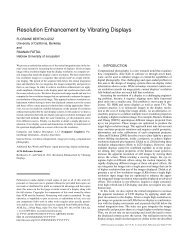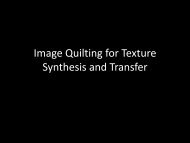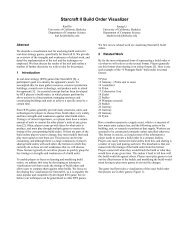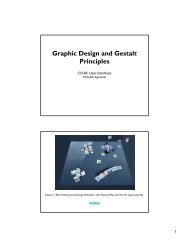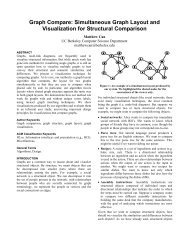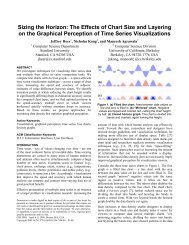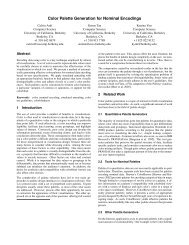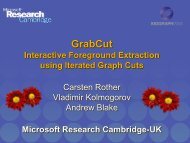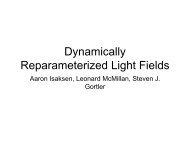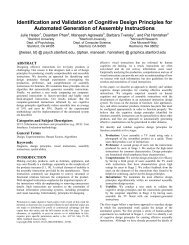Phrasing Techniques for Multi-Stroke Selection ... - Cornell University
Phrasing Techniques for Multi-Stroke Selection ... - Cornell University
Phrasing Techniques for Multi-Stroke Selection ... - Cornell University
- No tags were found...
You also want an ePaper? Increase the reach of your titles
YUMPU automatically turns print PDFs into web optimized ePapers that Google loves.
For most commands, such as lassoing objects and moving themas tested in our experiment, the creation of the implicit group isnot important and need not concern the user. However,knowledgeable users can specify more sophisticated operations byusing selection decorations and implicit groups together.Fig. 17 shows the Flip command with an implicit group. Here,we return to the example raised above, where a user wants to Flipthe objects (a,b,c,d) around the d. To do this, the user just crossesthe d, then lassos all four objects, and then pigtails to choose Flip.This causes the Flip command to rotate the implicit group aboutthe bottom of d. Once the command is finished, the selection isautomatically cleared, which results in our software ungroupingthe implicit group.Fig. 18. Alignment to center of implicit group. (a) Lasso items to<strong>for</strong>m implicit group. (b) Cross center of implicit group. (c) The centerof the implicit group is aligned with the bottom of the triangle. (d)Final result at completion of command; the implicit group isautomatically unpacked.The user can apply selection decorations to an implicit group,allowing composition of functionality. For example, the user canuse this capability to align the center of a group of objects toanother object without any explicit use of the “Group” command(Fig. 18). As another example, to instead flip (a,b,c,d) aroundtheir collective right edge, the user would first lasso the objects(thus creating the implict group), then cross the right edge of theimplicit group, and then choose Flip. This pivots the objects aboutthe rightmost edge. Implicit groups can also be nested by drawinga lasso that encompasses one or more previous lassos. Both ofthese interactions are illustrated in the accompanying video.Nested implicit groups obviously are a feature <strong>for</strong> expert users.Nonetheless, it seems compelling that a basic lasso selectionoperation in a pen interface, which test users immediatelyunderstood, can be used in more sophisticated ways byexperienced users.In practice, we would not expect a novice user to immediatelygrasp the full complexity that can be expressed with our selectionoperators. Yet these examples show how composing multipleselection operators allows experienced users to specify complexoperations without having to repeatedly Group, act on, and thenUngroup the objects. Because the commands in our prototypehave such general functionality, the command set as experiencedby the user can remain simple (Flip, Align, etc.). The spatialproperties needed to give specific meaning to a command comefrom the multiple strokes that together specify the selection.6.6 <strong>Selection</strong> RecallDuring early testing, users would become frustrated if theydrew one or more selection strokes, activated a command, butthen made a mistake or wanted to re-use the selection <strong>for</strong> anothercommand. It was frustrating <strong>for</strong> users to have to redraw the sameselection again. To our knowledge, existing graphical interfacesdo not include mechanisms to undo or redo selections, but itappears that one consequence of making selections moreexpressive in our system is that it may become necessary toinclude a feature to “recall” a prior selection.A naive full-tension design precludes the repeated invocation ofdifferent commands that act upon on the same selection. Toaddress this problem, we allow the user to tap twice on the modeswitch button to recall the prior selection. The user then holdsdown the button, and can modify the prior selection (if desired)be<strong>for</strong>e proceeding with a new command as usual. This works, butusers have to be told to tap the gesture key twice to invoke thisfeature. Users suggested a “recall selection” icon or a double tapof the pen as alternatives, but we have not yet tried these.7 CONCLUSIONS AND FUTURE WORKWe have conducted the first experimental study of interactiontechniques <strong>for</strong> phrasing of multiple-stroke gestures. We havedemonstrated how our prototype uses multiple-stroke phrasingtechniques to elegantly support selection techniques explored byprevious systems, including disjoint selection regions, circles ofexclusion, and bump/bite gestures. But our approach also enablesnew techniques, such as selection decorations and implicit groups,which allow <strong>for</strong> sophisticated functionality from a few generalpurposecommands. However, while we have conducted somein<strong>for</strong>mal user tests, these advanced features have not yet beensubjected to careful experimental studies.Our experimental results are consistent with the conclusion thatthe full-tension phrasing technique provides the strongestrein<strong>for</strong>cement of the chunking of multiple-stroke selection,command, and parameter phrases that our designs are trying toestablish. However, the low- and half-tension techniques workedwell enough that they could be considered as alternative multiplestrokephrasing techniques. For example, our full-tensiontechnique might not be practical <strong>for</strong> an electronic whiteboard thatlacks any button <strong>for</strong> the nonpreferred hand, or in some cases thespecific details of an application’s interaction techniques might beincompatible with the full-tension technique.We have described several benefits and extensions to existingtechniques that follow from supporting a multiple-stroke syntax<strong>for</strong> pen gesture interactions:• The ability to select objects using multiple strokes allowsadditional functionality, including more precise control overmultiple object selections, easier editing of selections, andnesting of multiple operations within a selection. Theresulting polymorphic commands also offer a nice economyof design, because the system can offer a single gesturecommand that acts on a wide variety of selections (e.g. Alignto right, Align to bottom, Align to horizontal center, etc).



